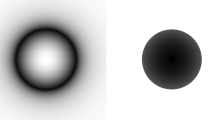Abstract
It is known that the Schrödinger equation may be derived from a hydrodynamic model in which the Lagrangian position coordinates of a continuum of particles represent the quantum state. Using Routh’s method of ignorable coordinates it is shown that the quantum potential energy of particle interaction that represents quantum effects in this model may be regarded as the kinetic energy of additional ‘concealed’ freedoms. The method brings an alternative perspective to Planck’s constant, which plays the role of a hidden variable, and to the canonical quantization procedure, since what is termed ‘kinetic energy’ in quantum mechanics may be regarded literally as energy due to motion.
Similar content being viewed by others
References
Thompson, J.J.: Applications of Dynamics to Physics and Chemistry, p. 15. Macmillan, London (1888)
Webster, A.G.: The Dynamics of Particles and of Rigid, Elastic, and Fluid Bodies, sec. 48. Teubner, Leipzig (1904)
Routh, E.J.: A Treatise on the Stability of Motion, p. 60. Macmillan, London (1877)
Macdonald, H.M.: Electric Waves, chap. 5. Cambridge University Press, Cambridge (1902)
Whittaker, E.T.: A Treatise on the Analytical Dynamics of Particles and Rigid Bodies, 4th edn, p. 54. Cambridge University Press, Cambridge (1952)
Byerly, W.E.: An Introduction to the Use of Generalized Coordinates in Mechanics and Physics, chap. 2. Ginn and Co., Boston (1944)
Goldstein, H.: Classical Mechanics, chap. 7. Addison-Wesley, Reading (1950)
Pars, L.A.: A Treatise on Analytical Dynamics, chap. 10. Heinemann, London (1965)
Lamb, H.: Hydrodynamics, chap. 6., 6th edn. Cambridge University Press, Cambridge (1932)
Whittaker, E.T.: From Euclid to Eddington, p. 84. Cambridge University Press, Cambridge (1949)
Holland, P.: Computing the wavefunction from trajectories: particle and wave pictures in quantum mechanics and their relation. Ann. Phys. 315, 503 (2005)
Holland, P.: Hydrodynamic construction of the electromagnetic field. Proc. R. Soc. A461, 3659 (2005)
Holland, P.: Quantum field dynamics from trajectories. In: Chattaraj, P. (ed.) Quantum Trajectories, chap. 5. Taylor & Francis, Boca Raton (2010)
Holland, P.: Symmetries and conservation laws in the Lagrangian picture of quantum hydrodynamics. In: Ghosh, S. K, Chattaraj, P. K. (eds.) Concepts and Methods in Modern Theoretical Chemistry: Statistical Mechanics, chap. 4. Taylor & Francis, Boca Raton (2013)
Holland, P.: Hidden variables as computational tools: the construction of a relativistic spinor field. Found. Phys. 36, 1 (2006)
Holland, P.: Hydrodynamics, particle relabelling and relativity. Int. J. Theor. Phys. 51, 667 (2012)
Guerst, J.A.: Variational principles and two-fluid hydrodynamics of bubbly liquid/gas mixtures. Physica A 135, 455 (1986)
Holland, P.: Schrodinger dynamics as a two-phase conserved flow: an alternative trajectory construction of quantum propagation. J. Phys. A 42, 075307 (2009)
Holland, P.: What’s wrong with Einstein’s 1927 hidden-variable interpretation of quantum mechanics? Found. Phys. 35, 177 (2005)
Acknowledgments
The author thanks the referee for helpful comments.
Author information
Authors and Affiliations
Corresponding author
Rights and permissions
About this article
Cite this article
Holland, P. Quantum Potential Energy as Concealed Motion. Found Phys 45, 134–141 (2015). https://doi.org/10.1007/s10701-014-9852-7
Received:
Accepted:
Published:
Issue Date:
DOI: https://doi.org/10.1007/s10701-014-9852-7




